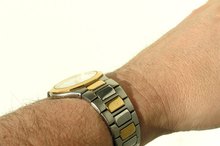Causes of Neck Rash
Rashes can appear anywhere on the body and cause varying symptoms. They can occur as localized red, itchy bumps or cause widespread breakouts. Those who experience rashes usually also have other signs and symptoms associated with it such as tenderness, peeling and dry skin. Typically, rashes develop from skin conditions or as a reaction to an irritating substance, but they may also be a sign of something more serious. A healthcare provider can assist in diagnosing and treating individual causes of a rash.
Heat Rash
Heat rashes are a prominent cause of a neck rash. This type of rash occurs from excessive perspiration during hot weather. Normally, perspiration evaporates on its own, but under harsh environmental conditions, perspiration can trap under the skin and cause the sweat glands to clog. Itchy or prickly skin, red bumps, inflammation and reduced sweating of the affected area can occur from clogged sweat glands 1. Young children and those who work in hot work environments develop a heat rash most often, but the condition can affect anyone. Common sites for heat rashes to develop include the neck and upper chest, elbows and under the breasts. Wearing lightweight clothing and avoiding ointments that can block the pores can assist in preventing a heat rash.
- Heat rashes are a prominent cause of a neck rash.
- Wearing lightweight clothing and avoiding ointments that can block the pores can assist in preventing a heat rash.
Dermatitis
What Are the Causes of Inflamed Scalp?
Learn More
Various types of dermatitis exist, and each can affect the skin differently. Dermatitis refers to an inflammation of the skin that can manifest from irritants, allergens, health problems and genetics. When dermatitis affects the neck, it usually occurs from contact dermatitis. Contact dermatitis occurs from direct contact with allergens or irritants that cause an irritation. The University of Maryland Medical Center reports that about 80 percent of contact dermatitis results from irritants and 20 percent results from allergens 2. Common irritants and allergens that produce contact dermatitis are cosmetics, jewelry, soaps, detergents and perfume. The signs and symptoms of contact dermatitis include dry, red patches; rashes and itching of the affected area; and pain and tenderness.
- Various types of dermatitis exist, and each can affect the skin differently.
- Dermatitis refers to an inflammation of the skin that can manifest from irritants, allergens, health problems and genetics.
Psoriasis
Psoriasis is a skin disease that occurs from problems with the immune system. The condition affects the life cycle of skin cells and causes irritation. Typically, skin cells take a month between growth and shedding, but psoriasis causes an acceleration of this process. As a result of this rapid skin-cell turnover, irritation occurs in the form of dry, cracked skin; itching and soreness; rashes and scaling skin. Psoriasis can cause direct symptoms to the neck or extend from the scalp. The National Psoriasis Foundation notes that at least 50 percent of people who have psoriasis have it on their scalp 3. Scalp psoriasis can extend beyond the scalp to the back of the neck, ears and forehead.
- Psoriasis is a skin disease that occurs from problems with the immune system.
- Psoriasis can cause direct symptoms to the neck or extend from the scalp.
Related Articles
References
- Skin Sight: Heat Rash or Prickly Heat
- University of Maryland Medical Center: Contact Dermatitis
- National Psoriasis Foundation: Scalp Psoriasis
- Maliyar K, Sibbald C, Pope E, Gary sibbald R. Diagnosis and Management of Atopic Dermatitis: A Review. Adv Skin Wound Care. 2018;31(12):538-550. doi: 10.1097/01.ASW.0000547414.38888.8d
- Kanani, A., Betschel, S.D. & Warrington, R. Urticaria and angioedema. Allergy Asthma Clin Immunol 14, 59 (2018) doi:10.1186/s13223-018-0288-z
- Martin SF, Rustemeyer T, Thyssen JP. Recent advances in understanding and managing contact dermatitis. F1000Res. 2018;7:F1000 Faculty Rev-810. Published 2018 Jun 20. doi:10.12688/f1000research.13499.1
- Atopic Dermatitis Practice Parameters. Ann Allergy Asthma Immunol. 2004;93:S1-21.
- Beltrani VS, Bernstein IL, Cohen DE, Fonacier L. Contact Dermatitis: A Practice Parameter. Ann Allergy Asthma Immunol. 2006;97:S1-38.
- Practice Parameters for Disease Management: Acute and Chronic Urticaria and Angioedema. Ann Allergy. 2000; 85: S525-44.
Resources
Writer Bio
Jonathan VanDam has written professionally for work assignments since 2006. He currently works in the counseling and academic fields. He obtained his Bachelor of Science in psychology from Mercy College in 2007 and Master of Science in psychology from University of Phoenix in 2009. VanDam is currently pursuing his Ph.D. in health psychology.









